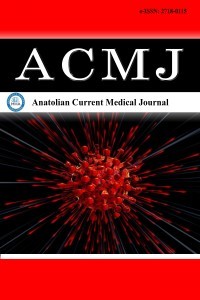
Anatolian Current Medical Journal
Yazarlar: ["Osman İNAN", "Muhammed Fatih ACEHAN", "Enes Seyda ŞAHİNER", "Meryem ASLAN", "Emin ALTIPARMAK", "İhsan ATEŞ"]
Konular:-
DOI:10.38053/acmj.1150437
Anahtar Kelimeler:Acute pancreatitis,Elderly,Scoring methods,Apache II,Roc curve
Özet: Aim: The issue of which scoring system is appropriate in older adults patients with acute biliary pancreatitis is an ongoing debate. We aimed to compare the efficiency of four existing scoring systems in predicting clinical outcomes in the elderly with acute biliary pancreatitis. Material and Method: The study included patients aged 60 years and older with a diagnosis of acute biliary pancreatitis. Clinical findings, routine laboratory examinations, and imaging findings were retrospectively accessed through the hospital information system and reviewed. Then, the efficacy of Ranson, Bedside Index of Severity in Acute Pancreatitis (BISAP), Glasgow-Imrie, and Acute Physiology and Chronic Health Evaluation (APACHE) II scoring systems in predicting mortality, severity, organ failure, complications, intensive care unit (ICU) admission, and prolonged hospital stay (PHS) were compared. Results: The Ranson score was compared with three other existing scoring systems in primary and secondary outcomes in 364 eligible patients. The area under the curve (AUC) values of the Ranson, BISAP, Glasgow, and APACHE II scores were 0.787 (95% CI: 0.649-0.925), 0.856 (95% CI: 0.784-0.929), 0.908 (95% CI: 0.854-0.961), and 0.836 (95% CI: 0.702-0.971) for mortality. Although the AUC of the Ranson score for mortality was lower than that of the other scores, no significant difference was found in pairwise comparisons with the other three scores (p>0.05 for all). Conclusion: The Ranson scoring system was the weakest among the assessed scoring systems in predicting clinical outcomes in older adults with biliary pancreatitis.